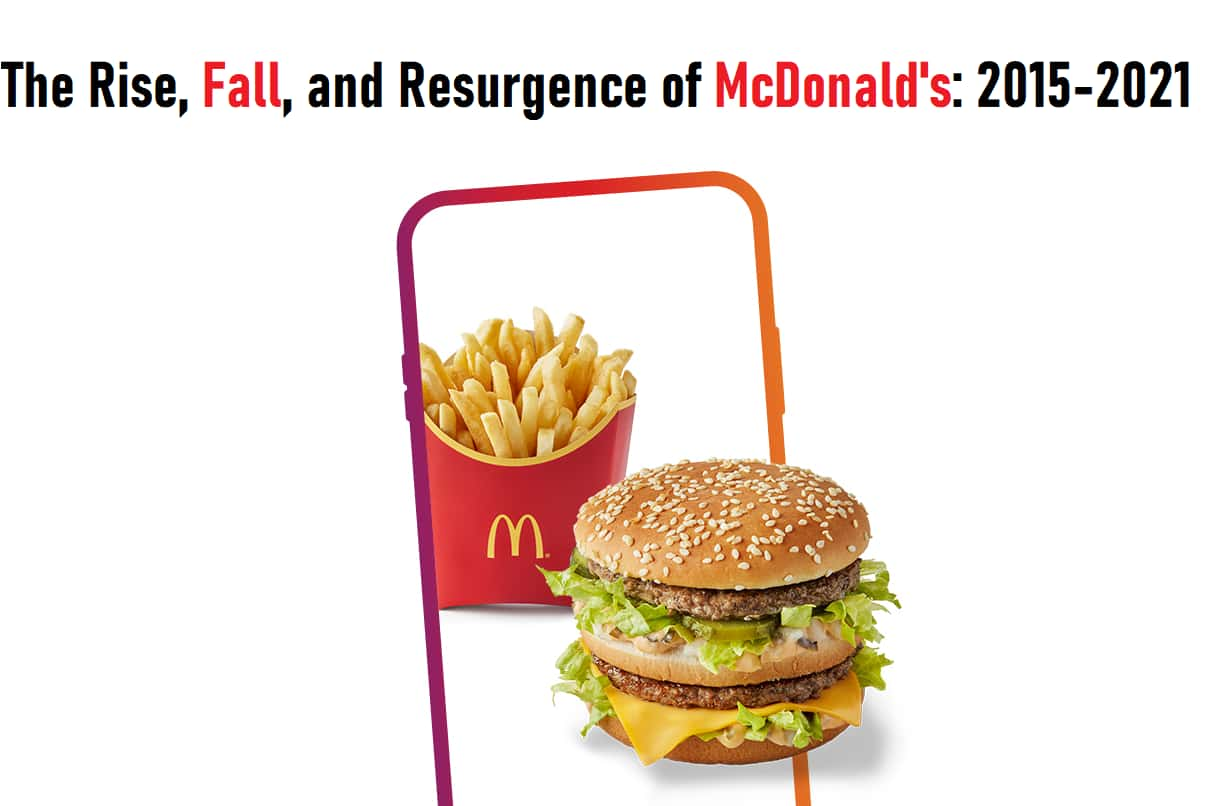McDonald’s, the world’s largest fast food restaurant chain, underwent a turbulent period from 2015-2021. Declining sales, changing consumer preferences, and internal issues put the company in crisis mode. However, bold decisions and calculated risks ultimately led to a resurgence.
The Downward Spiral (2015)
In 2015, McDonald’s found itself struggling on multiple fronts:
- Sales were down, with the company posting its first revenue decline in over a decade. Profits also sank 15%.
- Consumers increasingly wanted higher quality, more transparent ingredients. McDonald’s cheap, mass-produced image felt outdated.
- Competition was heating up from “fast casual” chains like Chipotle touting food made with wholesome ingredients.
- Millennials in particular were turning away from McDonald’s in favor of chains perceived as healthier and higher quality.
In response, McDonald’s tried upgrading its menu with more premium items like:
- “Create Your Taste”: $5-7 customized burgers
- New Chicken Clubhouse sandwiches
- Jalapeno Double burger
However, these new upscale offerings fell flat with core customers accustomed to McDonald’s as a cheap, convenient option.
Meanwhile, McDonald’s made decisions alienating franchise owners, who chafed at expensive renovations like self-order kiosks. Relations between corporate and franchises reached a low point.
By the end of 2015, McDonald’s posted its worst performance in over a decade, with net income plunging 30%. The CEO at the time, Don Thompson, stepped down. McDonald’s needed major changes to turn things around.
The Easterbrook Era (2015-2019)
In March 2015, Steve Easterbrook took over as McDonald’s new CEO. From the start, he implemented significant changes:
Revamping Company Structure
Easterbrook reorganized McDonald’s global operations around the following segments:
- U.S. market
- International Lead Markets (mature markets like UK, Australia, etc)
- High Growth Markets (China, Italy, Korea, etc)
- Foundational Markets (the remaining)
This aligned teams and marketing around different stages of market maturity and growth opportunities.
He also refocused the company on franchisees and set a goal of franchising 90% of stores within 3 years. This would provide more stable, predictable revenue from rent and royalties.
Investing in Technology
Easterbrook wanted to leverage technology to modernize operations. He invested heavily in:
- Self-order kiosks
- Mobile ordering apps
- Electronic menu boards
- Table service
This digitized the customer experience and freed up labor for customer service.
Focusing the Menu
With a cluttered, complex menu, McDonald’s streamlined down to core classics like the Big Mac, McNuggets, and Quarter Pounder. They trimmed premium sandwiches and customized burgers that failed to resonate.
simplicity, focusing less on permanent menu innovation and more on promotions and limited time offers. Promotions like All Day Breakfast proved popular for driving traffic without complicating kitchen operations long-term.
Delivery Partnerships
McDonald’s expanded delivery in partnership with UberEats, DoorDash, and GrubHub. Delivery sales reached $3 billion by 2019. Easterbrook recognized delivery would be key to growth.
The results of Easterbrook’s bold moves soon became apparent:
- Systemwide sales grew 5.5% in 2016 and 2017 – the strongest growth in 5+ years.
- Average sales per store reached an all-time high in 2019 of $2.9 million.
- Operating income rose 11% from 2018 to 2019.
- The stock price nearly doubled during Easterbrook’s first 4 years.
McDonald’s was clearly on the upswing thanks to its new strategy.
Fall From Grace (Late 2019)
In November 2019, McDonald’s fired Easterbrook for violating policy by engaging in a consensual relationship with an employee.
Despite the scandal, Easterbrook left McDonald’s much stronger than he found it. Chris Kempczinski, who joined McDonald’s in 2015 under Easterbrook, took over as CEO.
The Pandemic Years (2020-2021)
The COVID-19 pandemic posed new challenges for McDonald’s starting in 2020:
- Dine-in closures severely impacted sales
- Supply chain disruptions led to shortages
- New safety procedures increased costs
However, McDonald’s took proactive steps to manage the crisis:
- They leaned into drive-thru, delivery, takeout – channels less disrupted by dining room closures
- Marketing shifted to comfort food positioning – promoting McD’s reliability and familiarity
- New safety measures like contactless payment and tamper-proof delivery bags reinforced safety and cleanliness
Although sales still declined, McDonald’s fared much better than the overall restaurant industry in 2020. Global same-store sales fell just 7.7% for McDonald’s compared to 16% average for the industry.
By 2021, McDonald’s sales roared back thanks to:
- Famous Orders celebrity meal promotions (Travis Scott, BTS, Saweetie) driving social buzz and traffic
- Launching nationwide loyalty program MyMcDonald’s Rewards
- Opening with modern new restaurant designs focusing on convenience
McDonald’s is now as strong as ever. The company’s nimble and resilient response to COVID secured their spot at the top of the fast food industry for years to come.
Key Factors in McDonald’s Comeback
Several factors have fueled McDonald’s remarkable turnaround:
- Convenience: Streamlining menus, expanding delivery/drive-thru, and technology like mobile ordering all enhance convenience, McDonald’s historical strength.
- Value Focus: Positioning around value and affordability helped weather recessions and economic downturns. Discounting brought in budget-conscious customers.
- Calculated Risks: McDonald’s took risks on delivery, digital, and new formats while eliminating experiments like Create Your Taste that proved unsuccessful.
- Brand Trust: Customers see McDonald’s as a nostalgic, comforting option. Familiarity and ritual keep bringing diners back.
- Franchise Model: Franchising insulates McDonald’s from volatility. Rent and royalties provide stable cash flow even during sales slumps.
McDonald’s comeback remains ongoing. But the company’s resilience and willingness to evolve positions it well for the future. McDonald’s remains a dominant force able to fend off rising competition.
Timeline of Major Developments
| Year | Changes and Developments |
|---|---|
| 2015 | Sales decline for first time in over a decade. “Create Your Taste” custom burgers flop. CEO Don Thompson steps down. |
| 2015 | Steve Easterbrook becomes new CEO. Begins revamping menu, tech investments, structure. |
| 2016 | Launches All Day Breakfast, driving traffic. |
| 2017 | Rick & Morty Szechuan Sauce craze introduces idea of special pop culture promotions. |
| 2018 | $1 $2 $3 Dollar Menu relaunched. |
| 2019 | Hits all-time high of $2.9M average per store sales. |
| 2019 | Easterbrook fired for misconduct. Chris Kempczinski new CEO. |
| 2020 | Sales initially plummet during pandemic, but drive-thru and delivery save performance. |
| 2021 | BTS, Travis Scott celebrity meals drive sales rebound. Loyalty program launches. |
Financial Snapshot: 2015 vs. 2021
| Metric | 2015 | 2021 | Change |
|---|---|---|---|
| Systemwide Sales | $25.4 billion | $37.4 billion | +47% |
| Average Store Sales | $2.5 million | $2.9 million | +16% |
| Global Stores | 36,525 | 39,198 | +7% |
| Operating Income | $7.0 billion | $9.2 billion | +31% |
| Net Income | $4.5 billion | $7.5 billion | +67% |
| Stock Price | $120 | $270 | +125% |
In summary, McDonald’s has executed an impressive turnaround over the past 6 years. Key milestones included revitalizing the menu, embracing technology and delivery, realigning leadership and structure, and taking calculated risks that paid off. As a result, McDonald’s sales, profits, and stock have surged to new heights after hitting their lowest points in 2015. The resurgence reflects McDonald’s ability to reinvent itself and maintain dominance in a rapidly evolving restaurant landscape.












